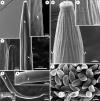Morphology, genetic characterization and molecular phylogeny of pinworm Skrjabinema longicaudatum n. sp. (Oxyurida: Oxyuridae) from the endangered Tibetan antelope Pantholops hodgsonii (Abel) (Artiodactyla: Bovidae)
- PMID: 33176841
- PMCID: PMC7656769
- DOI: 10.1186/s13071-020-04430-6
Morphology, genetic characterization and molecular phylogeny of pinworm Skrjabinema longicaudatum n. sp. (Oxyurida: Oxyuridae) from the endangered Tibetan antelope Pantholops hodgsonii (Abel) (Artiodactyla: Bovidae)
Abstract
Background: The Tibetan antelope Pantholops hodgsonii (Abel) (Artiodactyla: Bovidae) is an endangered species of mammal endemic to the Qinghai-Tibetan Plateau. Parasites and parasitic diseases are considered to be important threats in the conservation of the Tibetan antelope. However, our present knowledge of the composition of the parasites of the Tibetan antelope remains limited.
Methods: Large numbers of nematode parasites were collected from a dead Tibetan antelope. The morphology of these nematode specimens was observed using light and scanning electron microscopy. The nuclear and mitochondrial DNA sequences, i.e. small subunit ribosomal DNA (18S), large subunit ribosomal DNA (28S), internal transcribed spacer (ITS) and cytochrome c oxidase subunit 1 (cox1), were amplified and sequenced for molecular identification. Moreover, phylogenetic analyses were performed using maximum likelihood (ML) inference based on 28S and 18S + 28S + cox1 sequence data, respectively, in order to clarify the systematic status of these nematodes.
Results: Integrated morphological and genetic evidence reveals these nematode specimens to be a new species of pinworm Skrjabinema longicaudatum (Oxyurida: Oxyuridae). There was no intraspecific nucleotide variation between different individuals of S. longicaudatum n. sp. in the partial 18S, 28S, ITS and cox1 sequences. However, a high level of nucleotide divergence was revealed between the new species and its congeners in 28S (8.36%) and ITS (20.3-23.7%) regions, respectively. Molecular phylogenetic results suggest that the genus Skrjabinema should belong to the subfamily Oxyurinae (Oxyuroidea: Oxyuridae), instead of the subfamily Syphaciidae or Skrjabinemiinae in the traditional classification, as it formed a sister relationship to the genus Oxyuris.
Conclusions: A new species of pinworm Skrjabinema longicaudatum n. sp. (Oxyurida: Oxyuridae) is described. Skrjabinema longicaudatum n. sp. represents the first species of Oxyurida (pinworm) and the fourth nematode species reported from the Tibetan antelope. Our results contribute to the knowledge of the species diversity of parasites from the Tibetan antelope, and clarify the systematic position of the genus Skrjabinema.
Keywords: Genetic data; Morphology; Nematoda; Parasite; Phylogeny; Tibetan antelope.
Conflict of interest statement
The authors declare that they have no conflict of interest.
Figures





References
-
- Schaller GB. Wildlife of the Tibetan steppe. Chicago: University of Chicago Press; 1998. p. 373.
-
- Leslie DMJ, Schaller GB. Pantholops hodgsonii (Artiodactyla: Bovidae) Mamm Spe. 2008;817:1–13. doi: 10.1644/817.1. - DOI
-
- Yang GY. Advance on parasites and parasitosis of giant panda. Chin J Vet Sci. 1998;18:158–208.
MeSH terms
Substances
Grants and funding
LinkOut - more resources
Full Text Sources

